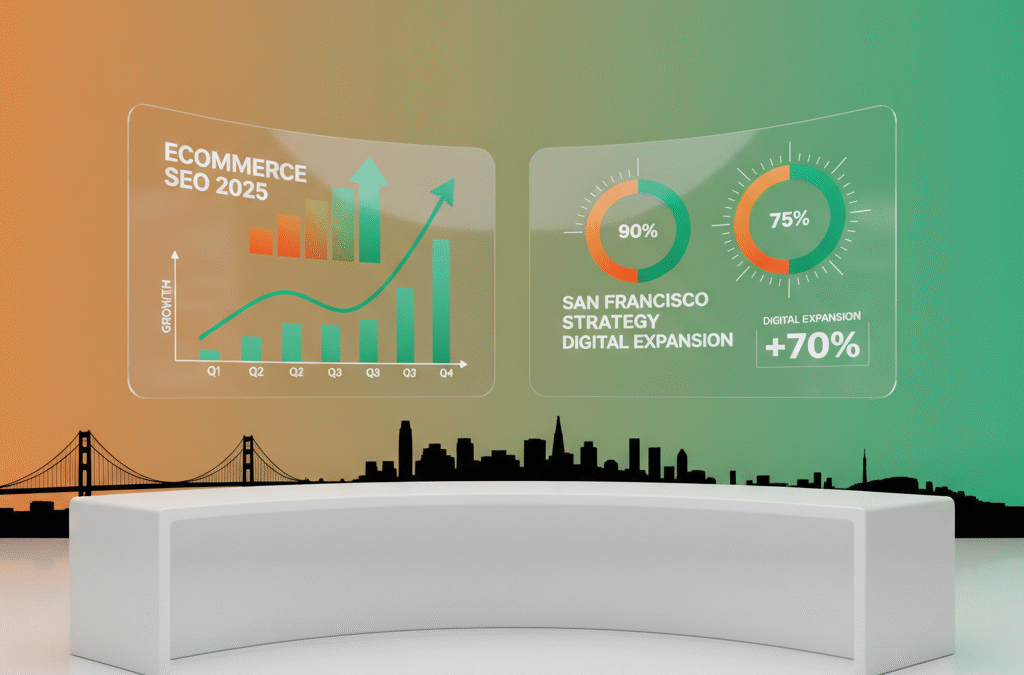Key Takeaways
- Many San Francisco ecommerce brands lose visibility because they are optimizing for outdated SEO strategies from 2019.
- AI-generated overviews now appear in 13% of searches, significantly reducing organic click-through rates by 64% when present.
- Customers increasingly use AI tools like ChatGPT to find product recommendations instead of traditional search queries.
- If your brand is not mentioned in AI-generated answers, it effectively becomes invisible to potential customers.
Table of Contents
- Why Most San Francisco Ecommerce Brands Are Invisible to Their Best Customers
- What Makes Ecommerce SEO Different (And Why San Francisco Stores Need a Specialized Approach)
- The Ecommerce SEO Stack: What Actually Moves the Needle in 2025
- Answer Engine Optimization: The New Frontier for Ecommerce Visibility
- Local SEO for San Francisco Ecommerce: Capturing High-Intent Neighborhood Traffic
- The 100-Day Traffic Sprint: How ESSO Co Accelerates Ecommerce Growth
- Choosing the Right Ecommerce SEO Partner in San Francisco
- Common Ecommerce SEO Mistakes (And How to Fix Them Fast)
- Measuring What Matters: Ecommerce SEO KPIs Beyond Rankings
- The Broader Shift: Why Multichannel Marketing Matters More Than Ever
- FAQ: Your Top Ecommerce SEO Questions Answered
Why Most San Francisco Ecommerce Brands Are Invisible to Their Best Customers
I’m seeing a troubling pattern with SF-based Shopify stores: strong brands with solid products losing visibility not because they’re doing SEO wrong, but because they’re optimizing for 2019’s search landscape. AI Overviews now appear in 13% of searches, and when they do, organic clicks drop by 64%. Your customers aren’t just Googling product names anymore, they’re asking ChatGPT “what’s the best sustainable skincare brand in San Francisco?” and if you’re not mentioned in that answer, you don’t exist.
The San Francisco ecommerce seo services san francisco market is uniquely challenging. You’re competing in hyper-competitive DTC categories while serving tech-savvy consumers who expect seamless digital experiences. Proximity to innovation means your buyers adopt new search behaviors faster, voice search, AI assistants, conversational commerce. Traditional SEO tactics like meta tag optimization and generic blog posts are table stakes now.
The real opportunity lies in Agentic SEO and Answer Engine Optimization. While your competitors chase yesterday’s ranking factors, smart SF brands are positioning themselves for tomorrow’s search reality where AI-powered content systems operate at scale and human strategy guides the direction. For a deeper dive into these evolving strategies, check out the ESSO Co blog.
What Makes Ecommerce SEO Different (And Why San Francisco Stores Need a Specialized Approach)

Ecommerce SEO operates fundamentally differently from service-based or B2B optimization. Your customers follow non-linear discovery paths: informational queries (“best running shoes for plantar fasciitis”), commercial investigation (“Hoka vs Brooks comparison”), and transactional searches (“buy Hoka Clifton 9 men’s size 11”). Your content architecture must capture all three stages, not just drive blog traffic.
San Francisco stores face unique considerations that generic ecommerce seo services san francisco providers miss. Local search behavior overlaps with broader market reach, someone searching “sustainable fashion SF Mission District” might become a nationwide customer. High cost-per-click in paid channels makes organic visibility critical, especially in competitive categories like wellness, tech accessories, and artisanal goods where SF brands cluster.
Technical Complexity Reality: Ecommerce sites manage product variants, inventory fluctuations, and filtered navigation that create thousands of URL permutations. Poor handling creates duplicate content penalties and crawl budget waste.
Commodity SEO tactics fail because they ignore ecommerce fundamentals. Compare a poorly optimized URL like yoursite.com/product-category/1234 versus a semantic structure like yoursite.com/mens-trail-running-shoes-waterproof. Google’s mobile-first indexing mandate means site speed and responsive design directly impact both rankings and conversions, technical debt kills growth. For more on technical SEO best practices, visit our main site.
The Ecommerce SEO Stack: What Actually Moves the Needle in 2025
Technical SEO: The Foundation That Makes Everything Else Possible
Site architecture determines whether search engines can efficiently crawl your catalog. Clean category hierarchies, semantic URL structures, and strategic internal linking create clear pathways from high-level collections to specific products. Core Web Vitals optimization, image compression, caching, CDN implementation, directly impacts both search rankings and conversion rates. Mobile-first design isn’t optional when Google indexes your mobile version first.
Schema markup for products, reviews, FAQs, and breadcrumbs enables rich results and increases likelihood of AI answer inclusion. Without proper structured data, you’re invisible to answer engines that rely on clear content signals to understand product relationships and attributes.
On-Page Optimization: Where Product Discovery Happens
Product page titles must match search intent while incorporating target keywords naturally. Generic manufacturer descriptions create duplicate content across thousands of products, programmatic content generation with unique value propositions and use cases solves this at scale. Strategic internal linking connects related products and complementary items, increasing session value and topical authority.
Image optimization extends beyond compression to descriptive alt text and contextual filenames that support visual search. Meta descriptions optimized for click-through rates, not just keyword placement, drive qualified traffic from search results pages.
Content Systems: Building Topical Authority at Scale
Thin blog content no longer ranks in competitive markets. Comprehensive buying guides, detailed product comparisons, and problem-solving content establish expertise and capture long-tail search volume. Programmatic content systems generate collection pages and FAQ hubs that target thousands of specific product queries without manual content creation bottlenecks.
User-generated content integration, reviews, Q&A sections, testimonials, provides fresh content signals while building social proof. Content clusters around high-value product categories create topical authority that elevates entire sections of your site.
Off-Page Signals: Earning Authority in a Skeptical Market
Quality link acquisition focuses on relevance over quantity, especially for local SF brands building trust with discerning consumers. Digital PR placements and strategic partnerships with complementary brands generate contextual authority signals. Social proof and review generation serve as indirect ranking factors while directly influencing purchase decisions.
Answer Engine Optimization: The New Frontier for Ecommerce Visibility
Buyers increasingly ask AI assistants “what should I buy?” rather than manually researching options. ChatGPT processes 2.5 billion daily prompts, approaching Google’s 14 billion daily searches. If your products aren’t mentioned in AI-generated answers, you don’t exist in the consideration set. This shift requires optimizing content for conversational queries, not just keyword matching.
Answer Engine Optimization (AEO) focuses on semantic relevance and source authority over traditional keyword density. When someone asks ChatGPT “What’s the best skincare routine for sensitive skin?” or searches Google with AI Overviews enabled, the algorithms prioritize content that directly answers questions with authoritative, structured information.
For San Francisco ecommerce brands, this shift represents a massive opportunity. Your product pages and content can appear in AI-generated summaries, featured snippets, and conversational search results, often above traditional organic listings. The key is creating content that serves both human shoppers and AI systems parsing for relevant, trustworthy answers.
I’ve found that structured comparisons, detailed FAQ sections, and comprehensive buying guides consistently surface in AI answers. When optimized correctly, these content types can capture traffic from both traditional search and emerging AI platforms, creating multiple pathways to product discovery. To learn more about how answer engine optimization is transforming ecommerce, read our latest blog insights.
Local SEO for San Francisco Ecommerce: Capturing High-Intent Neighborhood Traffic

Even primarily online stores benefit significantly from local SEO optimization in San Francisco’s competitive market. Local searches like “sustainable fashion Mission District” or “organic skincare SF” represent high-intent buyers who prefer supporting neighborhood businesses, even when shopping online.
Google Business Profile optimization remains foundational, accurate NAP (Name, Address, Phone) data, strategic category selection, and consistent posting schedule. For ecommerce seo services san francisco searches, local signals help establish credibility and proximity relevance. I recommend claiming and optimizing profiles even for home-based or warehouse-only operations.
Creating location-specific content without appearing spammy requires strategic finesse. Neighborhood buying guides, local partnership spotlights, and SF-focused product collections provide natural opportunities for geo-targeted optimization. Pop-up events, local market participation, and community involvement generate authentic local citations and backlinks that strengthen overall domain authority.
Local SEO Quick Wins for SF Stores
- Optimize Google Business Profile with recent photos and regular posts
- Build citations in SF Chamber of Commerce and local directories
- Create neighborhood-specific landing pages for high-value product categories
- Partner with local influencers and complementary businesses for cross-promotion

